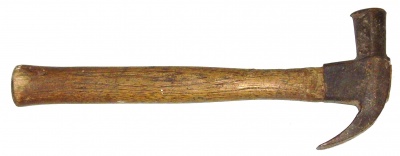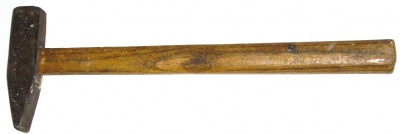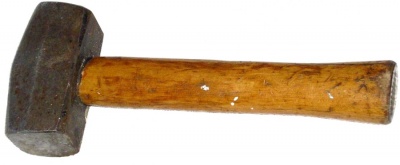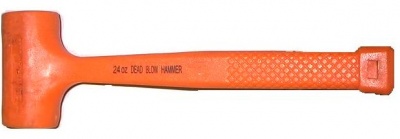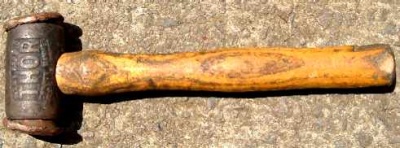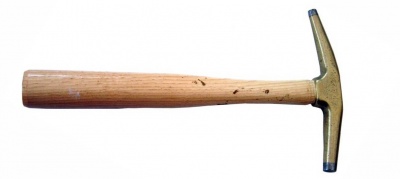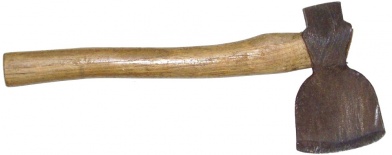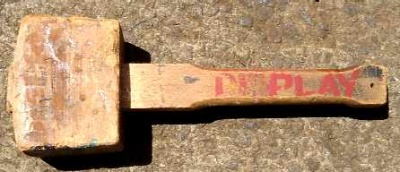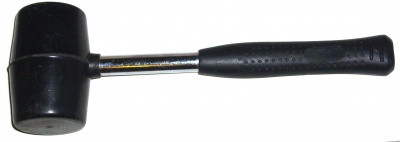Difference between revisions of "Hammer"
(→Hatchet: pic) |
(→Post Rammer: m) |
||
| (10 intermediate revisions by the same user not shown) | |||
| Line 4: | Line 4: | ||
==Hammers== | ==Hammers== | ||
===Claw Hammer=== | ===Claw Hammer=== | ||
| − | [[image: | + | [[image:Claw hammer 2825-2.jpg|400px]] |
* Most popular hammer for [[Special:Allpages|DIY]] | * Most popular hammer for [[Special:Allpages|DIY]] | ||
* General purpose hammer | * General purpose hammer | ||
| Line 11: | Line 11: | ||
===Cross Pein Hammer=== | ===Cross Pein Hammer=== | ||
| − | [[image: | + | [[image:Cross pein hammer 2771-2.jpg|400px]] |
* One flat face, one cold chisel face | * One flat face, one cold chisel face | ||
* Lighter hammer, 4oz & 8oz typical weights | * Lighter hammer, 4oz & 8oz typical weights | ||
| Line 23: | Line 23: | ||
* For metalwork | * For metalwork | ||
* also known as engineer's or machinist's hammer | * also known as engineer's or machinist's hammer | ||
| + | * The rounded face is used for shaping sheet metal | ||
===Club Hammer=== | ===Club Hammer=== | ||
| − | [[image:Club_hammer_105- | + | [[image:Club_hammer_105-8.jpg|400px]] |
* Fairly heavy hammer | * Fairly heavy hammer | ||
| Line 40: | Line 41: | ||
===Dead Blow Hammer=== | ===Dead Blow Hammer=== | ||
| − | [[image:Dead_blow_hammer.jpg|400px]] | + | [[image:Dead_blow_hammer 2.jpg|400px]] |
* No rebound | * No rebound | ||
* Hollow head contains shot | * Hollow head contains shot | ||
| Line 82: | Line 83: | ||
===Post Rammer=== | ===Post Rammer=== | ||
| + | [[image:IMAG2412-3 post rammer.jpg|right|75px|Post rammer]] | ||
| + | |||
* For hammering posts in | * For hammering posts in | ||
| − | * | + | * A large hollow tube with a closed top end plus handles |
* Placed on the post, its sides prevent it coming off the post in use | * Placed on the post, its sides prevent it coming off the post in use | ||
| Line 107: | Line 110: | ||
===Hatchet=== | ===Hatchet=== | ||
| − | [[image:Hatchet_622- | + | [[image:Hatchet_622-7.jpg|392px]] |
* Hammer and small axe in one | * Hammer and small axe in one | ||
| Line 123: | Line 126: | ||
===Rubber Mallet=== | ===Rubber Mallet=== | ||
| − | [[image: | + | [[image:Rubber mallet 2770-2.jpg|400px]] |
* Non-bounce rubber head | * Non-bounce rubber head | ||
* Softer than wooden mallets | * Softer than wooden mallets | ||
| Line 148: | Line 151: | ||
==Hammer Safety== | ==Hammer Safety== | ||
| + | A lot of minor injury is caused by hammers hitting fingers. Either keep the taps gentle while fingers are in the way, or use pliers to hold the [[Nails|nail]]. | ||
| + | |||
| + | A misstrike can send a [[Nails|nail]] flying. Use safety eyewear. This is important with [[Nails|masonry nails]], which are especially prone to missile-like behaviour, Sledge hammers can also impart huge energy to pieces of debris. | ||
| + | |||
| + | Hammers with a damaged head face tend to push nails sideways in use, increasing work times, increasing finger injuries and launching more [[Nails|nail]] missiles. Belt sand or replace them. | ||
| + | |||
| + | Hammers have hardened heads, and 2 hammers should never be struck against each other. | ||
| + | |||
Loose heads can be dangerous, and should be repaired with a wedge. A flying head can cause severe injury. | Loose heads can be dangerous, and should be repaired with a wedge. A flying head can cause severe injury. | ||
* Wood handled hammers are very prone to loosening in time | * Wood handled hammers are very prone to loosening in time | ||
* One piece metal hammers are immune to loose heads. | * One piece metal hammers are immune to loose heads. | ||
| − | + | ==Hardness== | |
| − | + | Metals, Brinell hardness: | |
| − | + | *600-700 Hardened Tool Steel | |
| + | *279 Soft steel | ||
| + | *150-190 Nickel Aluminum Bronze (Alloy #958) | ||
| + | *134 Malleable iron | ||
| + | *100 Yellow Brass | ||
| + | *70 Aluminium | ||
| + | *40-50 Copper | ||
| + | *30-40 Lead | ||
| − | + | Wood (Values vary significantly, these are only typical) | |
| + | *2.6 Birch | ||
| + | *6.9 Hickory | ||
| − | + | Plastics, from harder to softer: | |
| + | Gar-Dur Plastic | ||
| + | White Nylon | ||
| + | BASA | ||
| + | Urethane | ||
==See Also== | ==See Also== | ||
| Line 168: | Line 192: | ||
[[Category:Tools]] | [[Category:Tools]] | ||
| + | [[Category:Basics]] | ||
Latest revision as of 00:04, 23 July 2019
Picking the right hammer makes work easier.
Hammers
Claw Hammer
- Most popular hammer for DIY
- General purpose hammer
- Nail pulling claws on one side
- Various weights, with 12oz - 16oz being most popular
Cross Pein Hammer
- One flat face, one cold chisel face
- Lighter hammer, 4oz & 8oz typical weights
- For driving pins & small nails
- Easier to use & more precise than a claw hammer
- Limited hitting force available
Ball Pein Hammer
- One rounded striking face, one flat
- For metalwork
- also known as engineer's or machinist's hammer
- The rounded face is used for shaping sheet metal
Club Hammer
- Fairly heavy hammer
- 2 flat faces
- 1kg & 4lb are common sizes
- also known as a lump hammer, or baby sledge
- the weight makes some hammering tasks much easier
Sledge Hammer
- Very heavy hammer
- Long handle for maximum swing
- For serious violence, eg demolition, concrete breaking, splitting trunks with wedges, etc
Dead Blow Hammer
- No rebound
- Hollow head contains shot
- used for car work
- more at Wikipedia
Copper Face Hammer
- Does not produce sparks
- For high flammability situations
- a lot less likely to mark metal surfaces than steel hammers.
Brick Hammer
- 1 flat face, 1 masonry chisel face
- For brickwork
Scutch Hammer
- a development of the brick hammer
- Replaceable toolface
- For brickwork & masonry
- Cuts & dresses bricks
Chipping Hammer
- Spring handle isolates mechanical shock
- Chisel & flat striking faces
- Removes arc welding debris
Drywall Hammer
- Serrated face
- Small blade for cutting board
Fencing Pliers
- Hammer, wire cutter, wire twister, tensioner / puller all in one.
- For wire fencing
Rammer
- Flat head on a pole
- For vertical use
- For compacting bases
- Whacker plates & rollers are a lot more popular for most jobs.
Post Rammer
- For hammering posts in
- A large hollow tube with a closed top end plus handles
- Placed on the post, its sides prevent it coming off the post in use
Framing Hammer
- Larger claw hammer, heavier & longer
- Gives extra force for framing work
Shingler's Hammer
- Waffle face
- Hatchet type blade for breaking slates
- For roofing
Tack Hammer
- Upholstery hammer
- Small light hammer for tacks & brads
- Magnetised face holds fixings
Rock Pick
- Pointed spike on rear side
- For stonework
Hatchet
- Hammer and small axe in one
- 1-3 lbs
Mallets
Wooden Mallet
- Large rectangular head mallet
- For hammering materials that would be damaged by a metal hammer, eg wooden canes & posts
Carving Mallet
- Round wooden head
- For use with hand carving tools
Rubber Mallet
- Non-bounce rubber head
- Softer than wooden mallets
Plastic Mallet
- Non-porous plastic face
Handles
Hammer handles may be:
- Wood
- Fibreglass
- Steel
- One piece steel construction
Wooden handles are the cheapest, and usually come loose eventually, though it may take decades. They then require fixing with a wedge.
One piece steel hammers have no joint between head and handle, and never come loose. They are the highest cost type of hammer construction.
Handle Replacement
Hammer Safety
A lot of minor injury is caused by hammers hitting fingers. Either keep the taps gentle while fingers are in the way, or use pliers to hold the nail.
A misstrike can send a nail flying. Use safety eyewear. This is important with masonry nails, which are especially prone to missile-like behaviour, Sledge hammers can also impart huge energy to pieces of debris.
Hammers with a damaged head face tend to push nails sideways in use, increasing work times, increasing finger injuries and launching more nail missiles. Belt sand or replace them.
Hammers have hardened heads, and 2 hammers should never be struck against each other.
Loose heads can be dangerous, and should be repaired with a wedge. A flying head can cause severe injury.
- Wood handled hammers are very prone to loosening in time
- One piece metal hammers are immune to loose heads.
Hardness
Metals, Brinell hardness:
- 600-700 Hardened Tool Steel
- 279 Soft steel
- 150-190 Nickel Aluminum Bronze (Alloy #958)
- 134 Malleable iron
- 100 Yellow Brass
- 70 Aluminium
- 40-50 Copper
- 30-40 Lead
Wood (Values vary significantly, these are only typical)
- 2.6 Birch
- 6.9 Hickory
Plastics, from harder to softer: Gar-Dur Plastic White Nylon BASA Urethane
